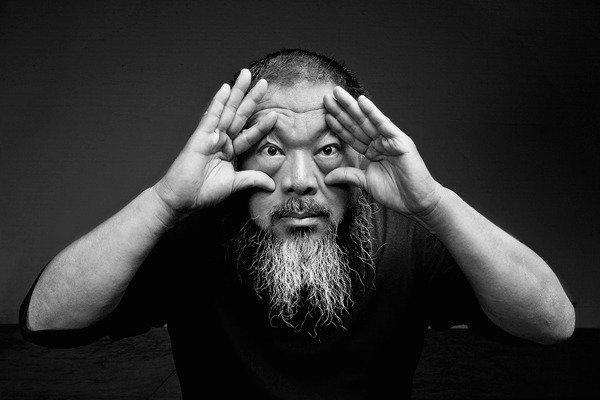By Heather Spaulding
Journal reporter
Ai Weiwei was just a baby when his father, poet Ai Qing, was sentenced to hard labor for defending intellectualism against the Cultural Revolution in 1958. The family was exiled to the far reaches of China’s Xianing providence, where they spent the next 16 years struggling to survive. These were experiences Weiwei would never forget and would later prepare him for a life as not only an artist, but an activist.
Weiwei’s art has been shown in the Tate Modern Museum in London, the Museum and Sculpture Garden in Washington D.C., Taipei Fine Arts Japan, Martin Grapius Berlin, as well as other venues across the globe. His human rights activism helped propel him into the spotlight. Headlines have called him the most dangerous man in China.
Human rights will be a major focus when the San Juan Islands Museum of Art brings “Ai Weiwei: Fault Line” to its halls Jan. 23 through April 11. The show, made up of several exhibits including photographs and sculptures inspired by the 2008 earthquake in Sichuan, China.
Approximately 70,000 people died in that earthquake, including more than 5,000 children attending school. The exact number of students killed remains unclear, as the Chinese government has refused to publicize that information, according to the documentary “Never Sorry” by Allison Klayman. Undaunted by the lack of documentation, Weiwei made it his mission to find out the name of each child, and calculate the exact number of casualties. He gathered volunteers of all ages for his Investigation of the Sichuan Earthquake.
One year after the quake, Weiwei began work on an intense untitled project in Munich, Germany. Across the façade of the Haus der Kunst Museum, he installed a wall of blue backpacks, bright pinks, yellows and other bright colors thrown in the mix representing the children lost in the disaster.
“The thing about Ai Weiwei is that he is an artist who hasn’t shied away from human rights. That is very rare in the art world,” said Ian Boyden, executive director of SJIMA.
Boyden himself lived in China for a number of years, and met several of Weiwei’s friends. It was through those contacts he was able to ask Weiwei if he would be interested in doing a show in Friday Harbor.
In 2012, Weiwei was awarded the Vaclav Havel prize for Creative Dissent from the Human Rights Foundation in New York. He is currently working on an exhibit in Lethos, Greece in an attempt to help refugees. Ai Weiwei has been very clear however, it is up to the audience to decide what his work means. In the case of the Chinese government, the work is threatening.
According to “Never Sorry,” officials have posted surveillance outside his studio in Beijing, interrogated him on multiple occasions, detained him for 81 days, beat Weiwei severely enough to cause a cerebral hemorrhage requiring emergency surgery, accused him of tax crimes for which there is no evidence, and shut down his blog.
“People say I am fearless, but I am not. I am fearful. I act more brave because I know the danger is really there. If you don’t act, the danger becomes stronger.” Weiwei says in the documentary.
In fact his childhood taught him the essence of survival in the face of that danger. Weiwei spent his youth on the edge of the Gobi desert, where the family found shelter in a cave while his father served out his sentence. Necessities like food and water were a daily struggle.
In the 1980s, Weiwei moved to New York City, during the Reagan era, and Iran-Contra hearings. He was part of the first generation to be able to study abroad under China’s new “opening up,” and while art engaged him, Weiwei could often be found watching TV, shocked a government would go through a cleansing process in public. He moved back to Beijing in the early 90s when his father’s health began to fail.
“Freedom is a pretty strange thing. Once you’ve experienced it, it remains in your heart, and no one can take it away. Then, as an individual, you can be more powerful than a whole country,” Weiwei says as he smiles wryly in the documentary “Never Sorry.”
For those not familiar with his work, Weiwei uses a combination of materials and mediums.
“He provides you with a set of pieces, and you, the viewer, get the pleasure of putting that together,” Boyden said, describing one of the exhibits in Fault Line, which is made up of coffin-like boxes. Within each box are pieces of replicated re-bar carved from marble.
If the re-bar was made out of iron, there might not be much of an impression, but marble usually has some other associations to it. Some might be reminded of ancient Greek statues, others counter tops, others still, may be reminded of tombstones. The marble was quarried from Sichuan, the very province where the earthquake occurred.
“So there are multiple layers in this piece. Now you, the viewer gets to test yourself. Is this political? Is it about equality? Depending on where you sit, your own experiences, is where you will draw your conclusions,” said Boyden.
The exhibit runs Jan. 23 until April 11. IMA is open 11 a.m. to 5 p.m. Friday through Monday.



